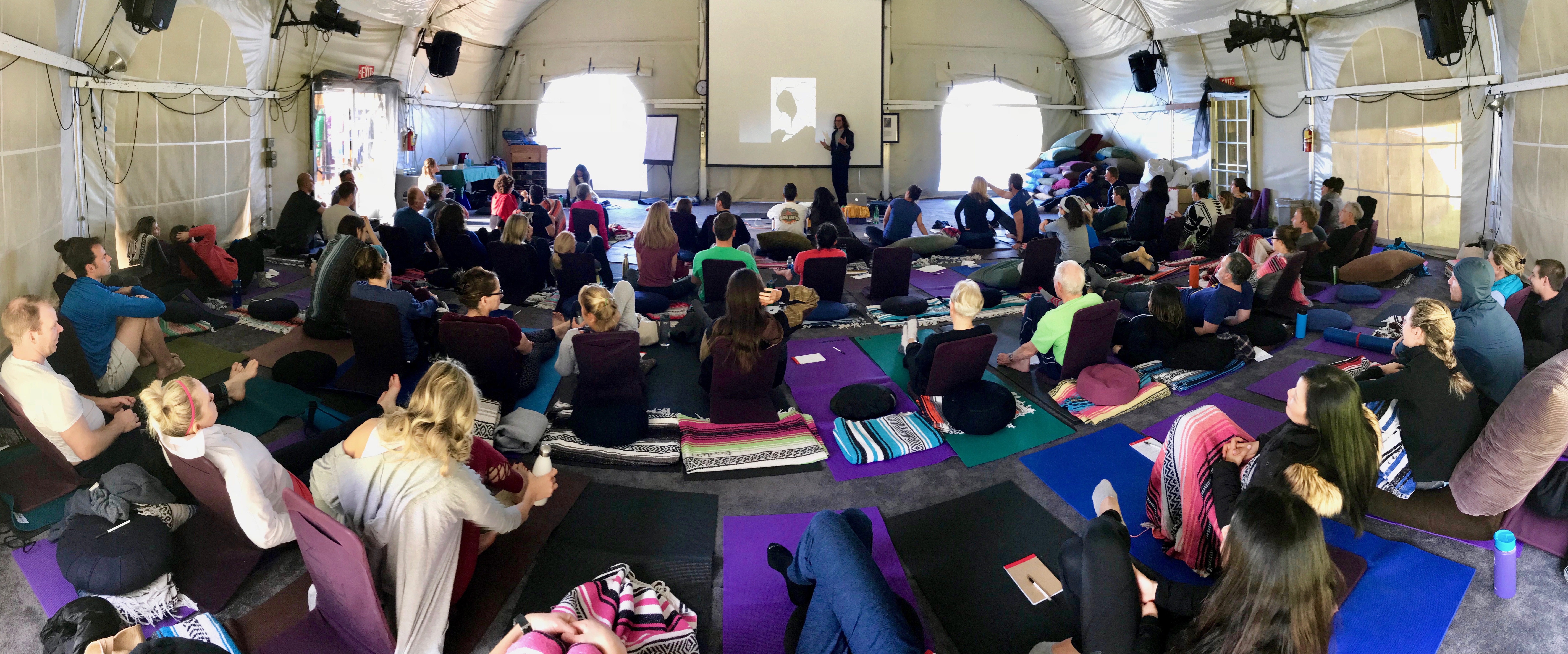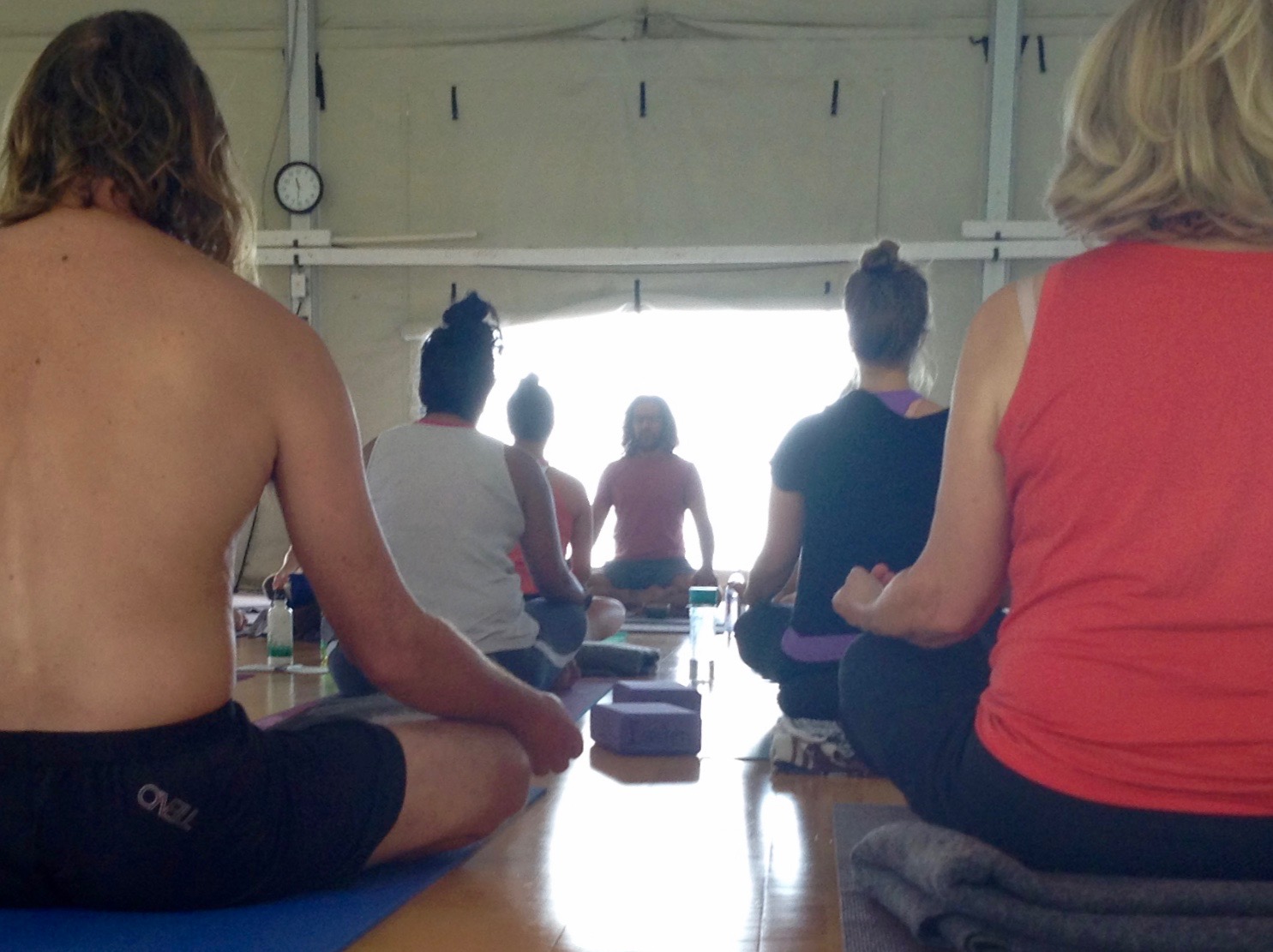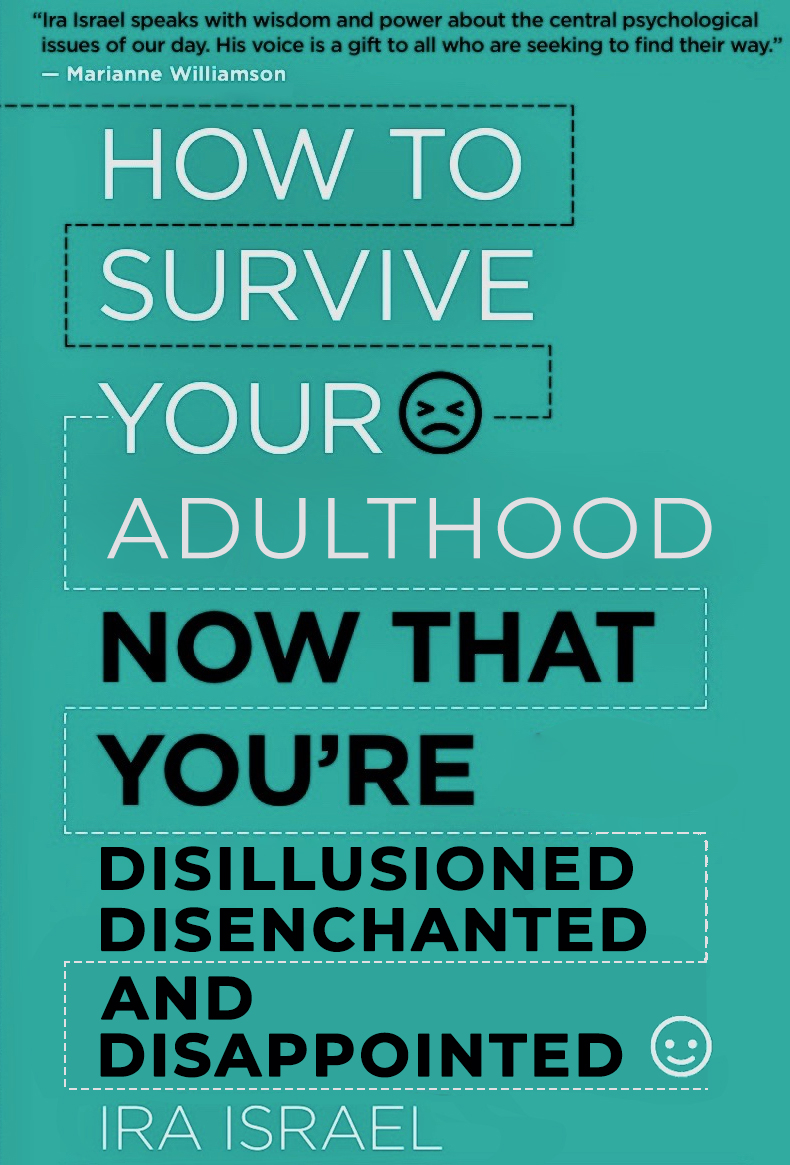From my 38 years of intellectual and psychological seeking, I have compiled a list of tools that I teach during my Esalen workshops. The following twenty exercises that help keep people at the higher ranges of their happiness spectrums are the ones that my students like best:
1. The three-part breath to take you out of fight or flight response mode
Due to the fact that we are sitting most of the day and jacking up our energy levels with caffeine, protein and sugar, unbeknownst to us we are in almost perpetual states of fight or flight. This is exacerbated by taking staccato breaths into just the bottom portion of our lungs when we sit. For this exercise we stand tall and think of our lungs as having three parts: the lower third that we can feel expand and contract through the bottom of the front ribs; the middle third that we can feel expand and contract through the thoracic spine; and the upper third that we can feel expand and contract near the clavicle bone at the bottom of the neck. I instruct students to slowly, “Inhale two three four; Exhale two three four” about 10 times as if I’m conducting a symphony. Inhaling, the “two” correlates to inhaling breath into the bottom of the lung, the “three” represents the middle of the lung, and the “four” represents the clavicle. Exhaling, the “two” correlates to the clavicle, the “three” correlates to the middle of the lung, and the “four” correlates to the bottom. We have the ability to take ourselves out of fight or flight mode by practicing the three-part breath with deep, long, fluid breaths for 3-5 minutes. For people who suffer from anxiety or think they may be starting to have a panic attack I recommend this exercise.
2. Fred Luskin problem solving exercise
Please take a pen and a piece of paper and write down any problem or several problems in your life.
For example:
PROBLEM(S): the brakes on my car didn’t last 60,000 miles and now I have to spend time and money unexpectedly getting them replaced. Or… my kids don’t return my text messages. Or… my boss doesn’t give me enough vacation time. Write down any problem or problems in your life.
Then write down any THOUGHTS you have about that problem or those problems.
For example:
THOUGHTS: The brakes should have lasted 60,000 miles. My kids should return my text messages in a timely fashion. My boss should give me more vacation time. My 401k should not have gone down.
Then write down any EMOTIONS you feel about the problem:
For example:
FEELINGS: I feel frustrated, I feel ripped-off, I feel disappointed, I feel sad, I feel as if my work isn’t respected.
Then write down any ACTIONS that revolve around or result from that problem.
For example:
ACTIONS: I find myself shopping online for new cars in the middle of the night. I find myself shopping online for lawyers who will take on a class-action lawsuit against the automobile company that promised my brakes would last 60,000 miles. I find myself passive-aggressively not responding to my kids’ text messages to make them understand how disrespectful they are. I binge eat. I binge drink. I binge shop. I binge xxxxxx. I show up late for meetings.
You now have a piece of paper that looks like this:
PROBLEM:
THOUGHTS:
FEELINGS:
ACTIONS:
Next please circle all of the THOUGHTS, FEELINGS, and ACTIONS that SOLVE the original problem.
Usually when we do this exercise there is silence, then nervous laughter ensues. After about 30 seconds I say, “That’s right, your thoughts feelings and actions DON’T solve your problems. Most of us are hard-wired for failure. We are hard-wired maladaptively. If you look closely, you’ll probably realize that your THOUGHTS, FEELINGS, and ACTIONS actually MAKE YOUR PROBLEMS WORSE!”

3. Know your core wound(s), the stimuli that trigger you, and how to react when the wounded child rears its dysregulated head
We all want to be loved unconditionally and during our childhoods we learned that our parents and caregivers smiled when we ate with forks and got good grades and frowned when we ate with our hands and failed our tests. Our subconsciouses may have assimilated these reactions as “People will abandon and betray you unless you act exactly how they want you to act” or “There must something wrong with me that I constantly don’t live up to other people’s standards” or “Nobody really cares about me” or “Screw them! Nobody can tell me what to do! I’m going to shave my head and get tattoos!” or some default message that is often accompanied by EMOTIONAL DYSREGULATION. When the wounded child in all of us emerges, things can get heated very quickly. There’s usually either crying or screaming or both. This is dysregulation. The adult cannot regulate their emotions when he devolves into his wounded child. Thus, this type of dysregulation – when childish insults are hurled and much drama is created – has to be nipped in the bud. Knowing one’s triggers and then either doing the above breathing exercise or taking a walk or doing whatever you need to do in order to regulate your emotions is paramount.
4. Know how you self-sabotage and how to auto-correct
As I discussed in “How To Survive Your Childhood Now That You’re An Adult,” we all need remissions to blow off a little steam. But when our remissions become addictions, then we are self-sabotaging. Also, if we recognize patterns that destroy relationships, that constitutes self-sabotage. Or we show up late for work or miss meetings – that is also self-sabotage. We have to recognize when we are not showing up with personal integrity to meet our commitments, see that as self-sabotage and cease such behavior immediately.
5. Metta Meditation to create a microcosm of safety, health and well-being
For metta meditations we usually practice them by reciting something such as:
- May I be safe
- May I be happy
- May I be healthy
- May I live with ease
Then we can wish the same things for a loved one, a stranger, someone with whom we have difficulties, and then for ourselves again. “Loving-kindness” (metta) is always available to us and this meditation creates a loving container and makes us aware of how much fear and needless animosity we consider to be “normal” in our lives. After going through the meditation for other beings we usually conclude by wishing safe, happiness, health and ease for all sentient beings:
- May all beings be safe
- May all beings be happy
- May all beings be healthy
- May all beings live with ease

6. How to create an anchor for clarity of consciousness, communications and sentiments every day
After practicing yoga or meditation, we sit and put our hands in prayer pose at our hearts, then raise our thumbs to our foreheads and ask for “Clarity of consciousness (for the rest of this beautiful day”); then lower our thumbs to our lips and ask for “Clarity of communications (with all of our friends and loved ones and with whomever we come into contact with – for the rest of this beautiful day”); then lower our thumbs back to our hearts and ask for “Clarity of sentiment (for the rest of this beautiful day”). When this exercise is practiced in the morning it usually establishes a steady anchor for even-keel regulation for the rest of the day.
7. How to replace the resentments that our minds create with gratitude
1. Rick Hanson taught me, “You can’t pull all of the weeds in the garden. But you can plant flowers.” Our minds were designed to create woulda-coulda-shoulda-didn’t resentments – to want things to be more/different/better – and these resentments are the root cause of our suffering. We cannot remove the resentments but we can displace them. We do this by planting flowers of gratitude. This is what is known in Cognitive Behavioral Therapy as gratitude lists. I recommend setting the bar as low as possible.
For instance:
I am grateful that…
- I have 2 legs
- I have human consciousness
- I have a few loving friends
- I have a roof over my head
- I have enough money to eat today
8. Reframing
Think of a problem:
- When do you have this problem?
- Where do you have this problem?
- Who are you with when you have this problem?
- Who are you when you have this problem?
- What are you aiming to achieve when you have this problem?
- What do you believe about yourself when you have this problem
- What skills do you have that enable you to have this problem?
- How could you teach me how to have your problem?
- How could you teach me to not have the problem?
- What skills would you need to STOP having this problem?
Reframing enables us to see what we are considering to be a “problem” through other lenses. Just to be provocative, I will recount an adage I heard some time ago: “Any problem that can be solved by money isn’t a problem.” There are many ways to think about the things that we consider to be problems.
9. “Clap last Thursday”
Eckhart Tolle says, “Either accept your life or change it; any other position is insane.” We cannot change the past; this is why I ask people to “Clap last Thursday” to prove to them that they cannot go back in time. Thus, the sooner we accept the past and OWN how we got to today, the sooner we will ameliorate our suffering. We cannot change the past so what good does it do to complain about it? Anytime our mind says, “I would be happy now if…. x happened or y didn’t happen” we are creating our own suffering.
10. Marshall Rosenberg’s Non-violent communications in order to reduce blame
I inspire people to be vulnerable, own their own emotional experiences, and reduce blaming others by employing one of Marshall Rosenberg’s Non-violent Communications exercises:
I feel __________________________________________
( a feeling state)
when __________________________________________
(something you observe happens)
because I need ___________________________________.
(an emotional need)
In the future, would you please_______________________.
(a request)
We cannot tell someone to be vulnerable but we can INSPIRE them by MODELING it for them. Non-violent communications is a wonderful tool to help us inspire loved ones show up in a non-blamey manner.
11. “How do we make this a win-win situation?”
Herbert Spencer’s dictum “Survival of the fittest” meant that life was a zero-sum game with winners and losers. This belief regarding supposed inherent competitiveness destroys relationships and is destroying the planet. Harville Hendrix once said, “You can either be right or you can be in relationship.” Instead of having a situation with a winner and loser, the parties should ask each other “How can we make this a win-win situation?”
12. Alternate nostril breath to balance masculine/feminine energies
Nadi Shodhana. There are countless nadi shodhana demonstration videos on YouTube. I like to hold up the right hand then fold down the first two fingers so that we can use the thumb to block off the right nostril and the ring finger and pinky to block off the left nostril. Like the three-part breath, I like to block off the right nostril then take a long fluid breath into the left nostril. We can count off 4 or 6 or 8 seconds, whichever feels good; then we block off the left nostril and exhale through the right nostril for the same 4, 6 or 8 seconds. Then we inhale through the left and exhale through the right for the same durations. There are many ways to practice nadi shodhana but if you believe Indian sages as well as Carl Jung, the right side of the body contains male energy while the left side contains female energy. Nadi shodhana balances the male and female energies in our bodies.

13. Love languages: Quality time, Words of Affirmation, Gifts, Acts of service, Physical touch
I’ve seen couples where one person will buy the other a $4,000 present but the person’s love language is Words of Affirmation, thus the present is meaningless. Couples need to know what they like to receive – what registers to them as “love,” and what they enjoy giving as symbols of love. Then they need to be on the same page so that they can stop claiming to have given symbols of love that completely miss the mark.
14. “What can we do to facilitate each other’s greatness?”
Eckhart Tolle writes in “The Power of Now” that the only reason you should be in a relationship is because you want to learn. I actually think that couples should work to facilitate each other’s greatness. As a “Pattern Interrupt,” in order to discombobulate the other person’s defensiveness, I like to have one of the partners ask, “What can I do to facilitate your greatness? I can’t be great unless you’re great. What can I do to facilitate that?” Try saying that to someone in your family and see what type of reaction you receive.
15. Cleaning up the past in order to show up authentically for the present
Forgiveness and self-forgiveness. This realizing of “At-onement” is sometimes a process so adding forgiveness and self-forgiveness into our meditation practices or adding some time to release all that does not serve us – anger, resentments, etc. – usually helps to lighten our daily loads.

16. Accident Victims and Lottery Winners
A scientific study regarding happiness was conducted that showed that human beings underestimate their resilience and overestimate the things that would make them happy. Most people say things like, “If I won $100 million dollars in the lottery I’d never complain again!” But that’s not accurate. In about 18 months whatever level of happiness we were at before we won the lottery we would fall back into. Similarly, if we were in an awful car accident and suffered from broken bones etc., after about 18 months we would be back to whatever level of happiness we were at before the car accident. This is why Positive Psychologists call it a “Happiness Spectrum” – because as long as we engage in constant healthy practices that keep us at the higher end of that spectrum, extreme events will not affect us dramatically.
17. Agency: Be More Pro-active
Many people feel as if they have attained certain measures of success and can take it easier thereafter. Human beings crave NOVELTY and novelty doesn’t usually come knocking on a closed door. At 40 years old I started riding a motorcycle, at 50 I started taking French classes, at 52 I took boxing classes for the first time, at 53 I took up tennis for the first time since high school, at 54 I started swimming classes. Being proactive – trying new things – is what keeps us vibrant. If you want to be authentically happy, then I advise being proactive in exploring new activities and interests.
18. Observing Thoughts Meditation: You are not your thoughts
My favorite meditations are visualizations where we put our thoughts in the form of phrases such as “I have to put the laundry in the dryer after meditation” onto either a leaf floating down a stream, a cloud floating through the sky, or a cartoon thought-bubble floating to the top of a pool, and watch them float away. We do this repeatedly and once we get the hang of it, we can feel the distance between the watcher and the thoughts. The fact is – even if you’re an atheist – that YOU are not (just) thoughts. Although our thoughts often trick us into thinking that they’re the most important things in the world – all-encompassing, and crucial – we can learn how to dis-identify with them and give them a much needed rest. We cannot tell the mind what NOT to think and the mind does not have an “off” switch. But we can learn how to observe our thoughts, watch them pass through our mental mindscreens, and actively CHOOSE not to react to them. Later in the day, long after this meditation wherein we have CULTIVATED NON-REACTIVITY, we can choose to let things that used to trigger us pass through us rather than stir up a reaction. As seen above in the Fred Luskin exercise, many of our instantaneous reactions are maladaptive. Thus, learning how to cultivate non-reactivity by observing our thoughts will help us make healthier long-term decisions in all circumstances.
19. Congruence – deciding the life you want to create
Congruence entails mitigating hypocrisy. It is having who we are, match who we know we should be. It sounds simple but it is essential to authentic happiness.
20. Autonomy
Having the autonomy to decide who we want to be and what tools will keep us authentically happy are privileges. So many people do not have autonomy because of insufficient means. Most of us have sufficient means to make choices and considering that 3.5 billion people live on less than $1.90 per day, we are fortunate to be able to have time to read articles like this one, meditate, exercise, decide where we want to live, what we want to study, how we want to earn money for food and shelter, etc. If we want to be keep ourselves at the higher ranges of our happiness spectrums then we must recognize our autonomy and make the best use of it.
(Excerpted from the forthcoming book “How To Survive Your Adulthood Now That You’re Disillusioned, Disenchanted, and Disappointed: Everything You Should Have Learned At School But Didn’t”)









